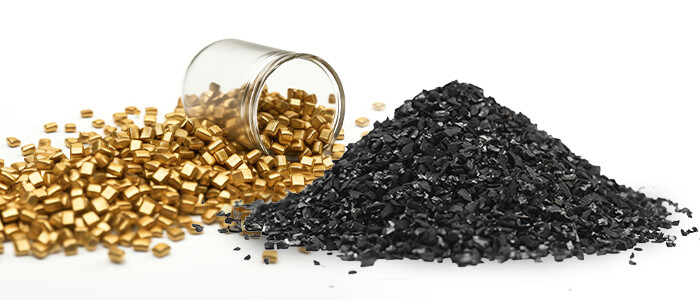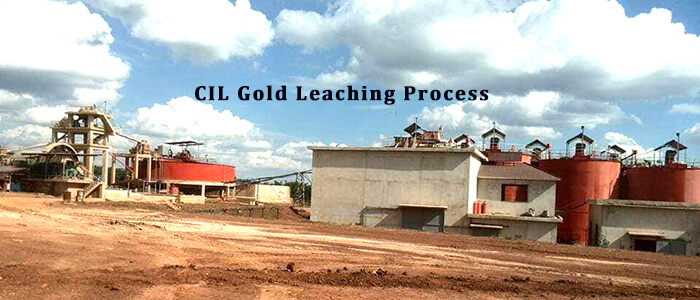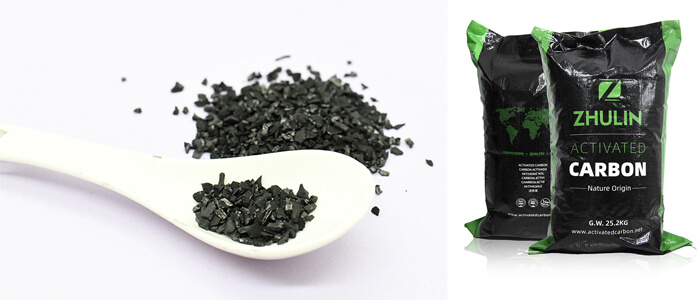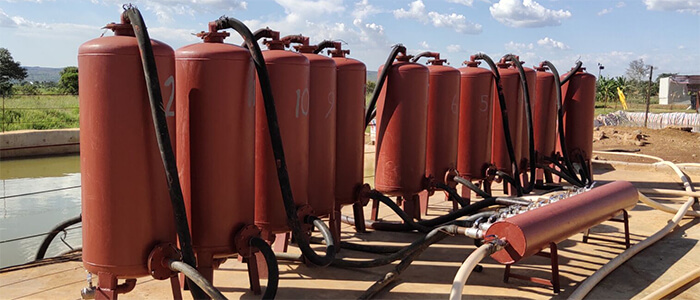Activated carbon plays a key role in the gold refining process. Its ultra-high porosity structure makes it a powerful adsorbent for gold recovery from cyanide solutions. After the metal ore is ground, it reacts with the cyanide solution to form a gold cyanide complex, and then the gold is adsorbed through activated carbon and recovered. Characteristics of activated carbon such as adsorption capacity, adsorption rate and particle size distribution are critical to gold recovery. As the most commonly used type, coconut shell activated carbon is ideal for gold extraction due to its superior hardness and pore structure.
Which is the most effective process for gold recovery?
Several processes are used for gold recovery, each with its own effectiveness and suitability based on the characteristics of the ore, environmental considerations, and cost-effectiveness. Some of the most common and effective processes for gold recovery include:Cyanidation (Carbon-in-Leach, Carbon-in-Pulp, Carbon-in-Column): Cyanidation is a widely used method in which gold is dissolved in a cyanide solution, allowing it to be extracted from ore. Activated carbon is used to adsorb the gold from the cyanide solution in processes like Carbon-in-Leach (CIL), Carbon-in-Pulp (CIP), and Carbon-in-Column (CIC).
Gravity Concentration:This method uses the differences in the density of gold and other minerals to separate them. Techniques like centrifugation, shaking tables, and spiral concentrators are utilized to separate gold particles from the ore.
Flotation:It involves the use of chemicals and air to create bubbles that adhere to gold particles, allowing them to float to the surface for recovery.
Heap Leaching:Ore is placed on a lined pad and treated with a cyanide solution that percolates through the ore to dissolve gold. The solution containing dissolved gold is collected and processed further.
Bioleaching:Some microorganisms can help dissolve gold from ore by releasing chemicals that break down minerals, making the gold more accessible for recovery.

The most effective process for gold recovery can depend on various factors such as the type of ore, its grade, geographical location, environmental regulations, and economic considerations. In many cases, a combination of these methods might be employed to achieve optimal gold recovery from ore.
What is active carbon for gold?
Activated carbon for gold, often referred to simply as "activated carbon" or "activated charcoal," is a specially processed form of carbon that plays a crucial role in the recovery of gold from cyanide solutions in the gold mining industry.
In the gold extraction process known as cyanidation, cyanide solution is used to leach gold from crushed ore. The gold is dissolved into the cyanide solution forming a complex, and this solution is then passed through activated carbon. The activated carbon adsorbs the gold from the cyanide solution, effectively concentrating it on the surface of the carbon particles.
Activated carbon's high surface area and porosity allow it to attract and hold the gold particles, separating them from the cyanide solution. This loaded carbon is then stripped of the gold through a process called elution or stripping, which allows for the recovery of the gold in a concentrated form.
The activated carbon used for gold recovery is specifically manufactured and treated to optimize its adsorption capacity and durability. It comes in various forms, including powdered, granular, or in the form of carbon pellets, and its properties can be tailored for specific gold recovery applications. Coconut shell-based activated carbon is commonly preferred for its superior properties in gold recovery processes.
What is the reagent for gold recovery?
In the context of gold recovery processes, various reagents are used at different stages to facilitate the extraction and recovery of gold from ores or solutions. Some of the primary reagents commonly employed in gold recovery include:
Cyanide:
Sodium cyanide or potassium cyanide is a key reagent used in the process of gold cyanidation, where it aids in dissolving gold from ores to form a cyanide-gold complex. This complex can then be separated and the gold recovered.
Activated Carbon:
While not a traditional reagent, activated carbon plays a vital role in gold recovery processes. It acts as an adsorbent for gold from cyanide solutions, allowing for the concentration and subsequent recovery of the gold from the activated carbon.
Acids and Bases:
Depending on the process, acids (such as hydrochloric acid or sulfuric acid) or bases (like sodium hydroxide) may be used for pH adjustment or as part of various chemical reactions involved in gold extraction and recovery.
Flocculants and Collectors:
In some cases, chemicals known as flocculants or collectors may be used in flotation processes to help separate gold particles from other minerals or impurities.
Mercury or Other Precipitants:
Historically, mercury was used in amalgamation processes to capture gold. However, due to environmental concerns, its use has been significantly reduced or prohibited in many places. Other precipitation reagents or methods are used to recover gold from solutions or concentrates.
These reagents are applied in specific stages and processes within gold extraction operations, each serving a distinct purpose in facilitating the separation, recovery, or concentration of gold from ores or solutions.
How is gold separated from carbon?
Gold separation from carbon is achieved through a process called elution. This process is employed to remove the adsorbed or loaded gold from the surface of activated carbon, allowing for the recovery of the gold in a concentrated form. Here's a general overview of how gold is separated from carbon:Loaded Carbon: Activated carbon, after being used to adsorb gold from cyanide solutions during the gold extraction process, becomes "loaded" or "pregnant" with gold. The gold particles are held on the surface of the activated carbon.
Elution Process: The gold-loaded carbon is introduced into an elution column or vessel. A hot solution, typically a cyanide solution mixed with sodium hydroxide or another suitable eluant, is passed through the column. The cyanide solution acts to desorb or strip the gold from the surface of the activated carbon.

Desorption of Gold: As the hot cyanide solution flows through the column, it breaks the bond between the gold particles and the activated carbon. This process releases the gold from the surface of the carbon, allowing it to dissolve into the solution.
Eluate Collection: The gold-laden eluate, the solution containing the dissolved gold, is collected from the elution process. This solution now contains the gold that was previously adsorbed onto the activated carbon.
Gold Recovery: The gold recovered in the eluate can be further processed through methods like electrowinning, precipitation with a reducing agent, or other refining processes to produce high-purity gold.
Carbon Regeneration: After elution, the stripped or bare activated carbon, still possessing its adsorptive capacity, can be regenerated for reuse in the gold recovery process. This involves removing any remaining gold or impurities from the carbon through thermal treatment or chemical regeneration methods.
The elution process effectively separates the gold from the activated carbon, allowing for the recovery of the gold in a concentrated form from the eluate. The recovered gold can then undergo further refining or processing to produce high-quality gold products.
How much gold can activated carbon absorb?
The adsorption capacity of activated carbon for gold can vary based on several factors, including the type of activated carbon used, its surface area, pore structure, the concentration of gold in the solution, and the specific conditions of the gold recovery process. Typically, activated carbon can adsorb a significant amount of gold per unit weight due to its high surface area and porous structure.
Activated carbon's adsorption capacity for gold is often measured in terms of its loading capacity or K-value, which refers to the amount of gold adsorbed per unit weight of activated carbon. This loading capacity can range widely and is influenced by the characteristics of the activated carbon and the conditions during the adsorption process.
In practical applications within the gold mining industry, activated carbon can effectively adsorb several grams of gold per metric ton of carbon. However, the exact amount can vary based on the specific type of activated carbon, the concentration of gold in the solution, the contact time between the carbon and the gold-bearing solution, and other process parameters.
Optimizing the conditions and choosing the appropriate type of activated carbon with the right characteristics are essential to maximize the gold adsorption capacity during the gold recovery process.
Conclusion
Activated carbon has become an indispensable solution for gold recovery, facilitating the efficient recovery of gold from cyanide solutions through its exceptional adsorption properties. At Zhulin Carbon, we specialize in providing high-quality activated carbon tailored for gold recovery, boasting superior adsorptive capacities and robust characteristics crucial for optimized gold extraction processes. Partner with Zhulin Carbon today for top-tier activated carbon solutions, engineered to elevate your gold recovery operations and ensure maximum efficiency. Contact us now to discover our specialized activated carbon offerings tailored for your gold beneficiation needs.

